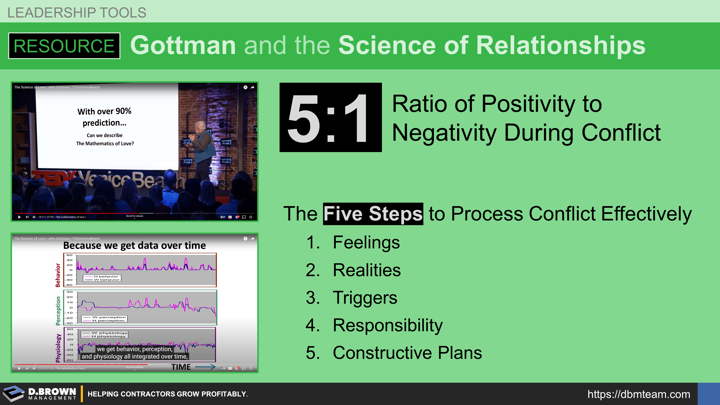From a holistic definition of wealth, great relationships starting at home form the foundation. For that reason alone, these resources are worth checking out.
For a contractor, especially those that are growing rapidly and are in stages 4, 5, or 6+, the relationships at the executive leadership and senior management levels are absolutely crucial. People, opportunities, and profits leak out of a contractor through gaps in the executive leadership team.
Brené Brown often references the work of John and Julie Gottman when describing how trust is built, broken, and repaired.
- The Science of Love (30 Minute Video / TED Talk by John Gottman Including the "Magic" 5:1 Ratio)
- Processing Conflict - The Aftermath of a Fight or Regrettable Incident. We've used a modified version of this to help with executive relationships extensively. Remember that in all relationships, conflict is not the problem, rather it is conflict that is dealt with poorly that is the problem. Great executive teams have constant conflict because they are making the highest leveraged decisions in the organization that rarely have clear right/wrong answers. The 5D Process is only effective when sitting on a foundation of trust and the capability to process conflict effectively when it arises. The Five Step Process simplified:
- Feelings: Share how you felt. Do not say why you felt that way. Avoid commenting on the other person's feelings.
- Realities: Describe your “reality.” Take turns. Summarize and validate at least a part of the other person's reality.
- Triggers: Share what experiences or memories you’ve had that might have escalated the interaction, and the stories of why these are triggers for each of you.
- Responsibility: Acknowledge your own role in contributing to the fight or regrettable incident.
- Constructive Plans: Plan together one way that each of you can make it better next time.
- The Gottman Institute website has a plethora of resources on it.
If you have any questions about how we have tailored some of these principles and tools for application with contractors and their teams, please contact us. We will share freely anything we have that will help.

